Every year, tens of thousands of people make glass here at CMoG. Most projects can’t be taken home on completion because the various glass objects must be cooled overnight and packaged for picking up or shipping the next day. On a single busy day in the summer, the Make Your Own Glass (MYOG) workshop can make hundreds of individual projects with visitors.
Just how do these projects end up in the right homes? Follow along and I’ll take you down the winding path of a MYOG project as it is processed. For this journey, we’ll follow a hot-worked item. The process for tracking varies a slight bit for different projects but, on the whole, it’s very similar.
It all begins with a ticket. These magical white slips of paper are printed by our guest service agents once visitors arrive at the museum. You can buy your tickets online (highly recommend in the summer) or in person once you arrive at the museum. There are a variety of projects to choose from.
- A Make Your Own Glass instructor taking down notes on color choices.
- The ticket has been marked with colors and if the guest will pick up or ship. Can you see the two series of numbers at the top left? Those are important if the guest is shipping.
With paper ticket in hand, you’ll travel to the location of your activity for the time printed on the ticket. At check-in, your MYOG instructor will proceed to write a secret code on the ticket. This code identifies the colors and various other identifying markers about your object. Your instructor will also note if you are shipping or picking up. This ‘S’ or ‘P’ is important on the following day when things are packaged.
- The MYOG instructor applies the colors that the guest has chosen, she’ll reference the ticket if she needs a memory boost.
- The finished flower! Ready to travel to the annealer.
Once your masterpiece is finished, your instructor will carefully put it away. The flowers go into the annealer. All of our annealers have metal grids in them that keep the objects in order. Once the object is in the annealer, an instructor will map your object. On this map, they will record the colors, shape and location in the kiln. They also make the project its own personal sticker. This sticker has a copy of your name and project description on it and becomes essential the following morning.
The last worker to leave for the day turns off the annealers. Annealing the glass is an essential step in the process. If glass cools too quickly it has too much internal stress and will crack and break. The next morning the first person to arrive unloads the projects. The carefully made stickers are peeled and stuck to the projects. Again, these are matched to the type, color and shape of the project. Then the items are wheeled on a cart into the MYOG processing area.
In the processing room, projects are sorted into pickups and shipping. Objects that are picked up are carefully matched with their ticket and wrapped for pickup. These go out to our front desk where they are held until the maker arrives to pick them up.
- The day’s bounty from the kiln, our flower is in front.
- MYOG projects all safely bagged and ready for pick up by their makers.
If the object is shipping, that’s a whole other journey.
Once in the processing room the object is matched with its ticket and, if there are any other projects being shipped to the same address, those are also placed on the shipping table. For this task, the customer number on the top of the ticket is used to group the items together and to match to the shipping address. Each reservation for MYOG is assigned a unique number, so if you have multiple projects under the same reservation they will all have the same number.
From the processing room, projects travel by cart to the shipping room. All shipping is matched with its tickets and arranged in groups to be placed into shipping boxes.
- These projects are being shipped to their makers. Each shipment is grouped together before packing.
- A typical view of our outgoing MYOG projects after a busy weekend.
For the safety of the glass, we wrap each piece in paper and follow that with bubble wrap. The bubble wrapped pieces are placed into a box on a fluffy pile of packing peanuts. Each box gets a fragile sticker and a shipping label. Once attached, the boxes wait patiently for our delivery carrier to pick them up and deliver them to you.
I hope this peek behind the curtain gives you a better understating of how your glass gets from here to there. Visit us soon and make your own glass!

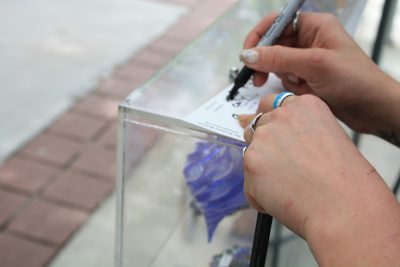

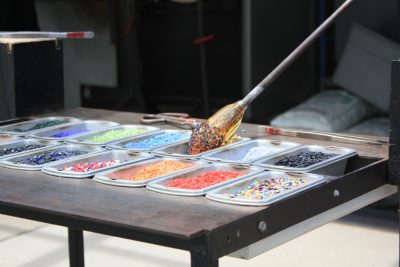
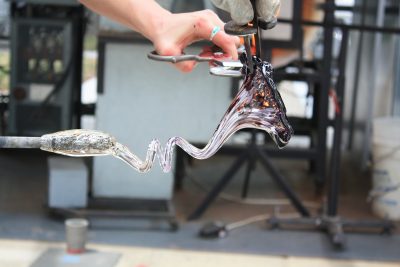

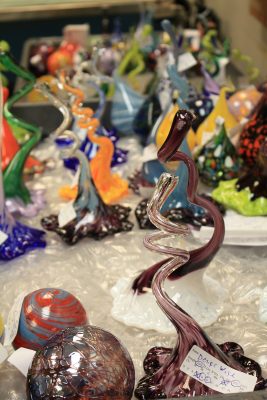

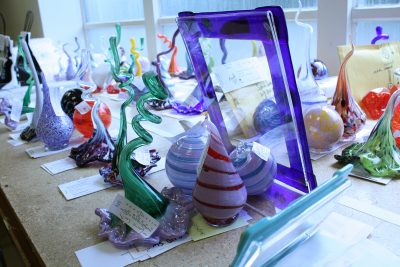
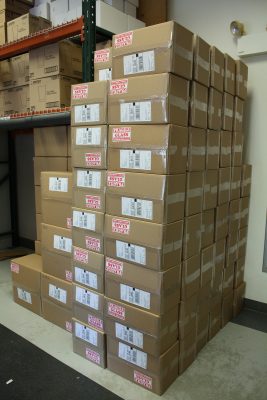
1 comment » Write a comment